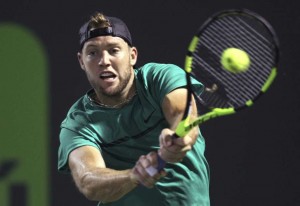By Randy Walker
@TennisPublisher
After his Miami Open quarterfinal loss to Rafael Nadal, Jack Sock can next look forward to a match next Friday on the other side of the planet against Jordan Thompson of Australia.
That’s who Sock will likely play as the No. 1 player on the U.S. Davis Cup team, drawn to face Thompson, the Australian No. 2 on the opening day of the USA vs. Australia Davis Cup quarterfinal next week in Brisbane, Australia.
Questions for U.S. Davis Cup Captain Jim Courier is who will be his No. 2 singles player who would play Australian No. 1 Nick Kyrgios on the opening day and who his doubles team would be, theoretically to play against Aussies Sam Groth and John Peers?
By the rankings, that Courier has often gone strictly by in selecting his playing positions, John Isner is the U.S. No. 2 at No. 23 in the ATP World Tour rankings, six slots lower than Sock at No. 17. However, Courier is armed with four top 30 singles players on his squad also including Sam Querrey at No. 27, and Stevie Johnson at No. 28. Isner’s head to head with Kyrgios is 2-1, losing the last meeting 7-6, 7-6 in the Atlanta final last summer. Querrey is fresh off beating the hot-headed Australian 3-6, 6-1, 7-5 in the semifinals of the Acapulco, Mexico, also on a hard court at sea-level like Brisbane. Courier could then save a fresh Isner to potentially play the live fifth match, if necessary, against Thompson, Isner showing the fortitude to win under pressure, best exemplified in his famous 70-68 win over Nico Mahut at Wimbledon.
Johnson seems more likely to pair in the doubles, potentially with Sock with whom he won Olympic bronze in Rio last summer. Johnson also reached the U.S. Open semis with Querrey in 2015 and the two paired together as a Davis Cup doubles team in 2015 against Uzbekistan. Johnson has also recently paired with Isner on the ATP World Tour.
In short, Courier has lots of options.
The U.S. will be playing in Australia for a second straight year due to an agreement 18 years ago determined during the Davis Cup Centennial in 1999 when Australia was forced to play for a second straight year against the USA in the USA to give a home match at Boston’s Longwood Cricket Club, the site of the first-ever Davis Cup matches in 1900 as part of the celebration. You can read about this controversy at the time and what led up to it and how it was resolved in a special ebook I wrote and published called “U.S. Davis Cup Team Stories – The 1999 Davis Cup Centennial,” that you can download on kindle here: https://www.amazon.com/dp/B01NB1FWU9/ref=cm_sw_r_tw_dp_x_ylr3ybHHS051Y

